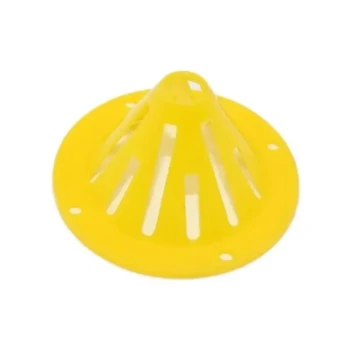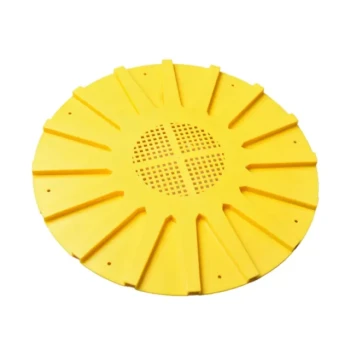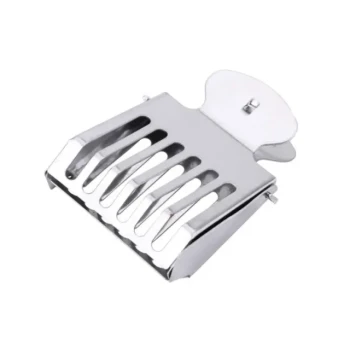The problem of blocked bees was resolved by creating an immediate, upward exit path using an unconventional placement of standard beekeeping equipment. The honey supers, which contained thousands of trapped bees, were removed from the hive and an Escape Board was placed on top of them like a ceiling, allowing the bees to fly out and return to the hive.
The core insight was to stop fighting the bees' confinement and instead reorient their environment. By providing an obvious upward escape, the solution leveraged the bees' natural instincts to solve the problem with minimal stress to the colony.
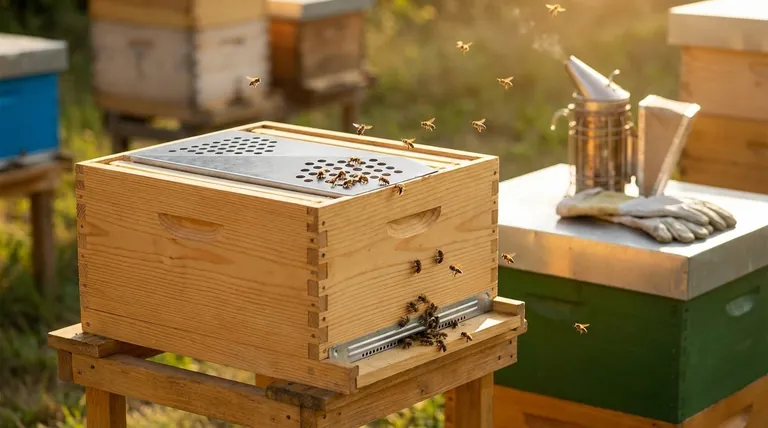
Diagnosing the Core Problem: Trapped Bees
The Initial State: A Congested Super
The issue began with thousands of bees confined within the honey supers. These are the boxes at the top of the hive where bees store surplus honey.
Normally, bees can move freely between the supers and the lower brood chamber. In this case, that path was either blocked or insufficient for the volume of bees.
The Blockage: An Ineffective Escape Route
When a beekeeper wants to harvest honey, they need to clear the bees from the supers. A standard Escape Board is typically placed under the supers to create a one-way exit down into the hive.
If this one-way gate becomes blocked or the bees cannot find the exit, they become trapped. This creates a stressful and potentially fatal situation for the bees and a significant problem for the beekeeper.
The Solution: Inverting the Escape
Step 1: Isolate the Problem
The first step was to remove the affected honey supers from the rest of the hive.
By setting them on a nearby table, the problem was isolated. This prevented further confusion at the hive entrance and allowed for a focused solution without disturbing the entire colony.
Step 2: Use the Escape Board as a Ceiling
The key innovation was to place the Escape Board on top of the supers, rather than underneath them.
This inverted its normal function. Instead of being a floor with a one-way exit down, it became a ceiling with a one-way exit up and out.
The Principle at Work: Leveraging Bee Instinct
Bees naturally move towards light and open air. By providing an exit at the very top, the solution gave the bees an immediate and intuitive escape path.
Once free, the bees simply oriented themselves and flew the short distance back to the main hive entrance, rejoining their colony.
Understanding the Trade-offs
Gentleness vs. Speed
This method is exceptionally gentle. It allows bees to leave at their own pace without the stress and aggression caused by shaking them off the frames or using a forced-air bee blower.
The trade-off is time. This is not an instantaneous solution; it relies on the bees finding the exit and choosing to leave. It is also dependent on weather conditions being suitable for flight.
A Situational Fix, Not a Universal Protocol
This clever fix works because the hive is nearby, providing a clear destination for the exiting bees.
It is a creative solution to a specific problem—a blocked escape—rather than a replacement for standard clearing methods that work correctly. Using an escape board in the conventional manner (underneath the supers) remains the standard for planned honey harvesting.
How to Apply This to Your Hive
When clearing bees, your method should align with your primary goal.
- If your primary focus is minimizing stress on the colony: Use a passive method like an Escape Board, ensuring it is placed correctly and the exits are clear 24-48 hours before you plan to harvest.
- If you discover bees are trapped or blocked: Consider this inverted escape method as a calm, effective way to resolve the situation without agitating the bees.
- If your primary focus is speed above all: Using a bee brush or a bee blower will clear frames much faster, but be prepared for more defensive and agitated bees.
Ultimately, effective beekeeping relies on observing the bees and adapting your technique to their behavior.
Summary Table:
| Aspect | Standard Method | Inverted Method (Solution) |
|---|---|---|
| Escape Board Placement | Under the honey supers | On top of the honey supers (as a ceiling) |
| Escape Direction | Down into the hive | Up and out into the open air |
| Best For | Planned honey harvesting | Resolving a blocked/trapped bee situation |
| Bee Stress Level | Low | Very Low |
| Speed | Slower (24-48 hours) | Slower (relies on bee discovery) |
Struggling with Hive Management Issues? Let HONESTBEE Equip You for Success.
This innovative solution highlights the importance of having the right equipment and knowledge to adapt to your bees' needs. Whether you're a commercial apiary managing thousands of hives or a distributor supplying beekeepers, having reliable, high-quality tools is essential for solving problems effectively and maintaining colony health.
HONESTBEE supplies the durable beekeeping supplies and equipment—like escape boards, honey supers, and more—that commercial operations and distributors trust. We help you be prepared for any situation, ensuring the well-being of your bees and the productivity of your operation.
Enhance your toolkit and be ready for anything. Contact HONESTBEE today to discuss your wholesale needs!
Visual Guide
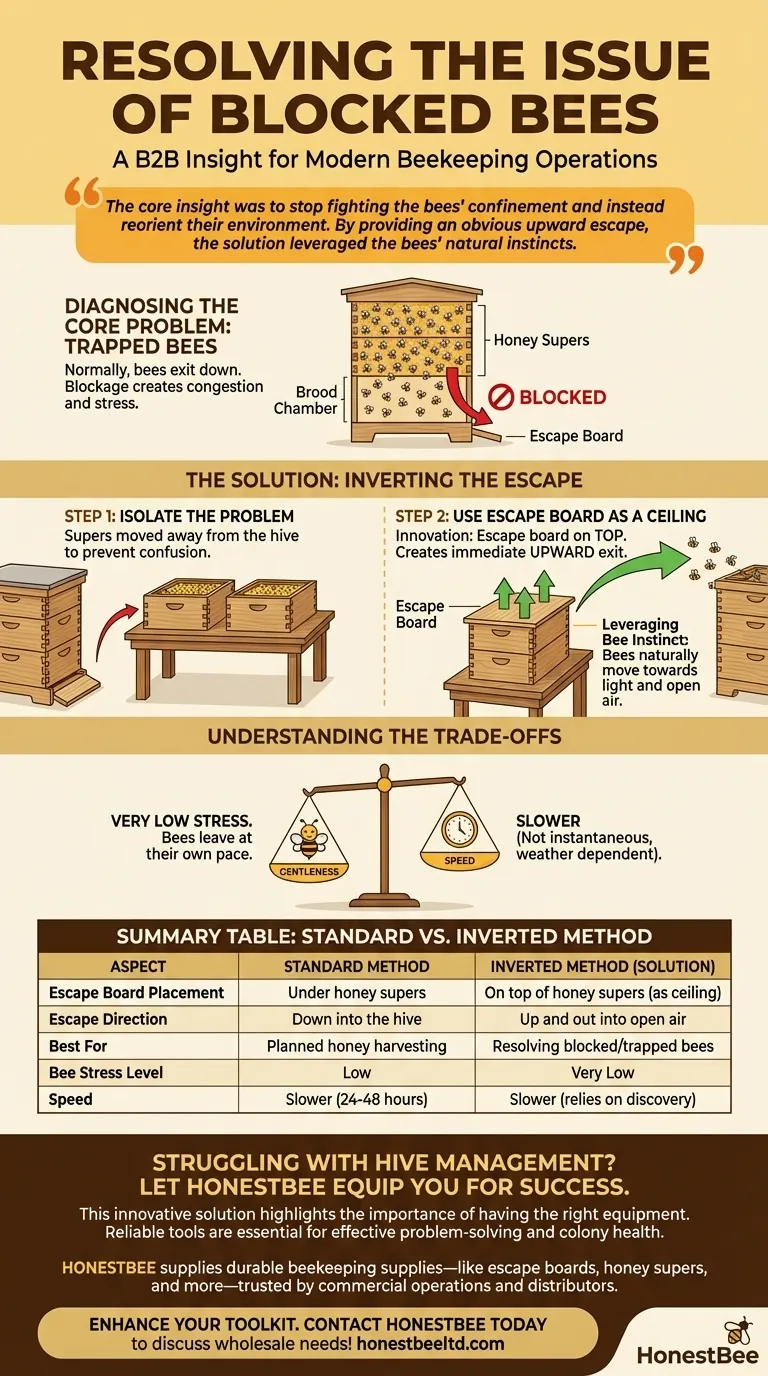
Related Products
- Heavy Duty Metal Corner Bee Escape for Reliable Hive Clearing
- Circular Labyrinth Bee Escape for Efficient Hive Management
- Slatted Porter Style Bee Escape for Rapid Hive Clearing
- Professional Durable Two-Piece Plastic Bee Escape
- High Performance Plastic Queen Excluder for Beekeeping and Apiary Management
People Also Ask
- What precautions should be taken when using the triangle escape board? Master Gentle Honey Harvesting
- What are the benefits of using an escape board? Achieve a Calm, Gentle Honey Harvest
- What is the effectiveness of the Bee Escape Board? Achieve a Calm, 95% Bee-Free Honey Harvest
- What should be considered when choosing a Triangular Escape Board? Ensure a Proper Fit for a Calm Harvest
- What issue occurred with one of the hives during the honey harvest? Feral Comb Blocked the Bee Maze


